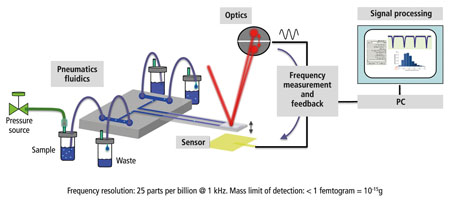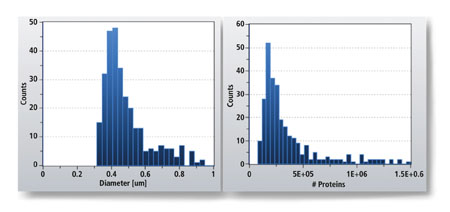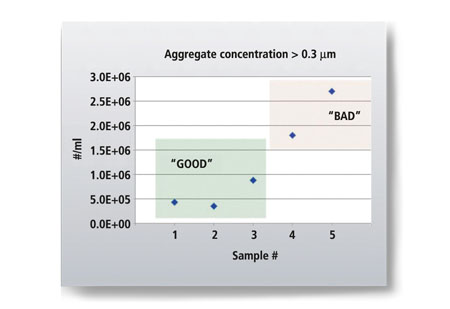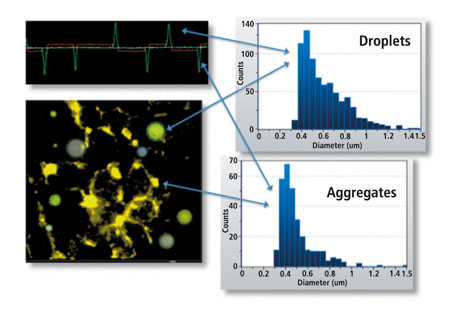As work on biological molecules accounts for an increasing proportion of R&D expenditure in drug discovery and development, analytical testing is under the spotlight in the rapidly expanding biopharmaceutical sector. Not only is the cost of developing these molecules very high, this heavily regulated industry also constantly demands more appropriate and rigorous analytical measurements. Many in the sector have cited analytical bottlenecks as a major cause for concern and likely to constrain drug development.
Unlike small molecule drugs, therapeutic proteins are not synthesised or crystallised and they are intrinsically heterogeneous. As such, the definition of purity and potency for biotherapeutics is much more complex than it is for non-biological molecules. Impurities, for example, can originate from any number of sources, including the therapeutic molecule itself in the form of aggregates or ‘misfolded’ or completely denatured structural forms.
Consequently, the analytical technology needed for quality assurance and control, and which will provide the data necessary for pre-formulation and formulation, is quite different when compared with the pharmaceutical industry’s small molecule norm. This complexity and variability is leading to many new challenges for manufacturers and regulators alike.
Selecting suitable candidate molecules involves – among other analyses – various physicochemical testing processes that are designed to rule out those molecules that may become ‘problem children’ further downstream. One of the most important questions to be answered is how these molecules will behave in formulation, and a significant area of concern is protein aggregation, not least because of the potential for aggregates to trigger an immune response.
One of the most important questions to be answered is how these molecules will behave in formulation, and a significant area of concern is protein aggregation
Regulators have identified potential immunogenicity concerns surrounding protein aggregates from 0.2µm to 2µm in diameter, but currently available particle measurement techniques do not adequately deliver quantitative data throughout this size range. They may tell you that particles of that size are present, but not how many are present. A technique that is filling this gap is that of Resonant Mass Measurement (RMM) and it is being applied via the Archimedes system (marketed and distributed outside North America by Malvern Instruments) to both size and, most importantly, count particles from 50nm.
The principle of resonant mass measurement relies on having a mechanically resonant structure to which mass can be added or subtracted. This addition or subtraction shifts the structure’s resonant frequency either up or down, providing the basis for mass measurement because frequency can be measured very precisely. To measure the mass of very small particles suspended in fluid, a microfluidic channel is embedded inside the resonator. As a suspended particle passes through the structure, it alters the mass of the overall resonator, thereby shifting its resonant frequency.
As shown in Figure 1, the time course of the particle is that it enters the resonator at position 1, the excursion in the resonant frequency reaches a maximum at the end of the resonator at position 2, and returns to the baseline when the particle exits at position 3.
It is the excursion in resonant frequency from the baseline that enables the measurement of the mass of a particle. In the case of buoyant particles, such as oil droplets, the opposite effect is observed, with the resonant frequency making a positive excursion from the baseline.
Applying resonant mass measurement to particles of very small mass and size requires the use of resonators that have very little mass themselves. In Archimedes, micro electro-mechanical system (MEMS) sensors enable this. Each sensor chip comprises a microfluidics network and a minute cantilever that resonates with a particular frequency. Embedded in this cantilever is a microfluidic channel. As the instrument’s fluidics system pushes sample through this channel, the resonant frequency of the cantilever alters. This shift in the frequency of resonance is measured by a laser, focused on the tip of the cantilever, which is then transmitted to a split photodiode detector (see Figure 2).

Figure 2: Resonant mass measurement instrument set up (Archimedes, Malvern Instruments)
Each particle that passes through the sensor causes a change in the resonant frequency, giving an accurate and precise measurement of the individual particle’s buoyant mass – whether positive or negative – in the sample. From this measurement, the mass, size (equivalent sphere) and surface area of the particle can be calculated. Overall measurements are also made of sample concentration, density, volume and polydispersity.
Quantifying protein aggregates
Protein aggregates start at the dimer level and go all the way up to tens of microns in diameter; aggregates at the upper end of this range are usually measured using flow microscopy. Resonant mass measurement extends the range below flow microscopy, measuring from the submicron range to a few microns, sizes not easily assessed quantitatively by other means. This range is also where immunogenicity concerns and new regulatory interest tend to lie.
Figure 3(a) shows the size distribution of submicron IgG protein aggregates present in 4µL of formulation buffer. The measured concentration of aggregates using RMM is 4 x 106 aggregates/mL for sizes greater than 300nm. Because the underlying measurements are of mass, the distribution can be displayed as the number of protein molecules (of known mass) that make up each aggregate (Figure 3b).

Figures 3a and 3b: Aggregate detection using Archimedes
Figure 3c shows measurements of protein samples subjected to increasing shear stress over a period of time, and illustrates the growing concentration of aggregates measuring from 300nm to 1µm throughout the experiment. The 10-fold increase in aggregates of this size roughly corresponds to an aggregation cascade and the concentration of submicron aggregates correlates with deteriorating formulation quality under stress.

Figure 3c: Aggregate detection using Archimedes
Detecting contaminants
Another popular topic in the analysis of protein formulations is the presence of silicone oil, which is often used as a lubricant inside the syringes and containers that hold the formulations. Silicone oil frequently sloughs off into the formulation and forms oil droplets of a similar size to the aggregates. The issue is not primarily one of biocompatibility as the oil is generally thought to be safe. Of greater concern is the tendency of the oil droplets to be misperceived by some measurement methods as protein aggregates, therefore compromising the accuracy of the results.
RMM can distinguish silicone oil droplets from protein aggregates through buoyancy measurements. In Figure 4, for example, negative peaks in the frequency trace represent aggregates of densities greater than that of the suspension buffer. Silicone oil droplets, whose density is generally less than that of the buffer, produce positive peaks in the frequency trace because their presence reduces the overall mass of the sensor and therefore increases the sensor’s resonant frequency. Separate distributions are presented for each population.

Figure 4: Demonstrating the ability to distinguish between protein aggregates and contaminating silicone oil droplets
A technology for today
Critical to the successful application and acceptance of RMM technology, as implemented within a routine analytical instrument, is the key size range it addresses for protein aggregation measurement. Just as important when dealing with scarce amounts of such highly valuable materials is that measurements can be made on just 100µL of sample having viscosities up to 100 cP and with no sample preparation required.
With its ability to detect and accurately count particles in the size range 50nm – 5µm, and reliably measure their buoyant mass, dry mass and size, Resonant Mass Measurement is an attractive proposition for protein characterisation.
Quantitative information on formulation and stability will potentially translate into information about efficacy and stability and RMM is already being used to detect and quantify aggregates present in bioformulations early in development, supporting the ideal of ‘fail early, fail cheap’.
Malvern sets up Bioscience Development Initiative
The traditional model of getting an analytical instrument to market, which often involves taking years to perfect the final product, is not appropriate to the biopharmaceuticals sector, where this approach carries an inherent risk of ending up answering yesterday’s question.
Those at the forefront of biopharmaceutical research need analytical tools to solve today’s problem, and the challenge for providers lies in anticipating the unknowns in a field where rapidly evolving analytical and regulatory requirements continue to test all concerned. There is a need to understand what can be measured, what will provide meaningful predictive information about quality, and to anticipate the kind of measurements needed in the future.
Those at the forefront of biopharmaceutical research need analytical tools to solve today’s problem, and the challenge for providers lies in anticipating the unknowns
Malvern has taken a radical approach to working in this sector by creating a global Bioscience Development Initiative that recognises the unprecedented pace of development in biopharmaceuticals and the onus this places on analytical instrumentation companies to deliver compelling solutions quickly to a host of rapidly evolving analytical and regulatory challenges.
The establishment of an agreement to market the Archimedes system was one of its first outputs, with further technology developments emerging as fully-fledged products during the course of this year.
Key to its success is an open approach to high-level partnering for technology development, and the establishment of nimble technology and product development processes that focus on the analytical needs identified.
The Bioscience Development Initiative operates from facilities close to Washington DC and is headed by Malvern’s Chief Technology Officer Dr E Neil Lewis, who leads a dedicated group of scientists, engineers and business development personnel who are separate from, but with close links into, Malvern’s core teams. Their work is focused specifically on the requirements of the biopharmaceutical sector, most notably the biochemical and biophysical characterisation needs relating to formulation and product development.
This dedicated programme is resulting in close collaborations with biopharmaceutical companies, technology innovators and leading academic institutions. By establishing such mutually beneficial relationships Malvern gains a rapid understanding of emerging industry requirements to which it can quickly respond, while the biopharmaceutical sector gets very early access to, and helps shape, the leading edge technology developments it so urgently needs.




